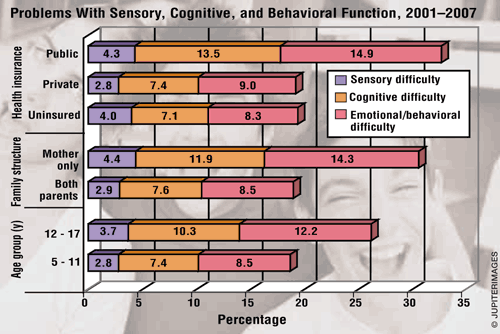US Pharm. 2010;35(1):10.
One aspect of the National Health Interview Survey examines the relationship between health care factors and impairments to a child's functioning. From 2001 through 2007, functional difficulties in basic actions (sensory, cognitive, and emotional/behavioral) in children aged 5 to 17 years remained fairly stable at 18% (9.4 million). Three percent of children (1.8 million) had sensory difficulties, 9% (4.7 million) had cognitive difficulties, and 10% (5.5 million) had emotional/behavioral difficulties.
Children aged 12 to 17 years had more difficulty with basic actions (21%) than children aged 5 to 11 years (15%). More boys (22%) than girls (14%) had trouble with basic actions. Children in mother-only families (24%) had more difficulties than those in two-parent families (15%).
Types of Functional Problems
Sensory: Children with public health insurance (4%) and uninsured children (4%) had more sensory problems than children with private insurance coverage (3%). Children in mother-only families (4%) had more sensory difficulties than children in two-parent families (3%). Among children with sensory difficulties, 88% had problems with seeing, 11% had problems with hearing, and 1% had problems with both.
Cognitive: Children who were covered by public health insurance had more cognitive problems (14%) than children with private insurance (7%) and uninsured children (7%). Eighty-six percent of children with cognitive problems had learning disability or difficulty remembering, and 3% had a diagnosis of mental retardation, Down's syndrome, or autism; the remaining 11% had both 1) learning disability or difficulty remembering and 2) a diagnosis of mental retardation, Down's syndrome, or autism.Emotional/Behavioral: Children with public insurance had more emotional/behavioral difficulties (15%) than children with private health insurance (9%) and children who were uninsured (8%). Forty-nine percent of children with emotional/behavioral difficulties were diagnosed with attention-deficit/
Health Care Factors
Children who had difficulties with basic actions had more frequent contact with a medical specialist (24%) than children without these difficulties (11%). Among children with basic-action difficulties, those who were covered by private health insurance (27%) and those who had public health insurance (22%) had more frequent contact with a medical specialist than children who were uninsured (11%). Children in mother-only families (26%) had more contact with a medical specialist than children in two-parent families (22%).
Children who had difficulties with basic actions used prescription medication on a regular basis (39%) more frequently than children without these difficulties (10%). Among children with basic-action difficulties, boys used more medications (42%) than girls (35%). Children with health insurance (private, 41%; public, 42%) used more medications than children who were uninsured (22%).
Early identification of functional difficulties and timely initiation of relevant health care, therapies, and educational services can help lessen the influence of these problems on a child's development.
To comment on this article, contact rdavidson@uspharmacist.com.




